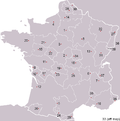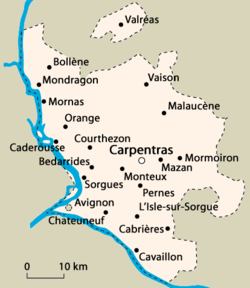- Comtat Venaissin
-
Comtat Venaissin
Comtat Venaissin (fr)
Coumtat Venessin
Comtat Venaicin (oc)Papal enclave ← 
1274–1791  →
→

Flag Coat of arms Capital Venasque, Carpentras Government Monarchy Historical era Middle Ages - Death of Alfonso
Count of Provence
21 August 1271- Acquired by Papacy 1274 - Capital moved to
Carpentras
1320- Avignon sold by Joan,
Countess of Provence
1348- French occupation 1663, 1668, 1768–74 - Incorporated into France
by plebiscite
14 September 1791The Comtat Venaissin, often called the Comtat for short (Occitan: lo Comtat Venaicin, la Comtat in classical norm and lou Coumtat Venessin, la Coumtat in mistralian norm), is the former name of the region around the city of Avignon in what is now the Provence-Alpes-Côte d'Azur region of France. It comprised roughly the area between the Rhône, the Durance and Mont Ventoux, with a small exclave located to the north around the town of Valréas. The entire region was an enclave within the Kingdom of France. The Comtat also bordered (and mostly surrounded) the Principality of Orange. Avignon itself was, however, never part of the Comtat but constituted a separate comtat (county) in its own right, in effect forming an enclave within an enclave. The region is still known informally as the Comtat Venaissin, although this no longer has any political meaning.
History
In 1096, the Comtat was part of the Margraviate of Provence that was inherited by Raymond IV, Count of Toulouse from William Bertrand of Provence. These lands in the Holy Roman Empire belonged to Joan, the hereditary Countess of Toulouse and wife of Alphonse, Count of Poitiers.[1] Alphonse had bequeathed it to the Holy See on his death in 1271. Since this happened during the interregnum, there was no Holy Roman Emperor to protect Joan's rights. The Comtat became a Papal territory in 1274. The region was named after its former capital, Venasque, which was replaced as capital by Carpentras in 1320.
 Map showing the Comtat and the Principality of Orange in 1547
Map showing the Comtat and the Principality of Orange in 1547
Avignon was sold to the Papacy by Countess Jeanne of Provence in 1348, whereupon the two comtats were joined together to form a unified Papal enclave (though retaining their separate political identities).
The enclave's inhabitants did not pay taxes and were not subject to military service, making life in the Comtat considerably more attractive than under the French Crown. It became a haven for French Jews, who received better treatment under papal rule than in the rest of France. The oldest synagogue in France, built in the 14th century, is in Carpentras. Until the French revolution they preserved a distinctive Provençal ritual.
Successive French rulers sought to annex the region to France. It was invaded by French troops in 1663, 1668 and 1768–74 during disputes between the Crown and the Church. It was also subjected to trade and customs restrictions during the reigns of Louis XIV and Louis XV.
Papal control persisted until 1791, when an unauthorized plebiscite was held and the inhabitants voted for annexation by France. It was subsequently incorporated into the Vaucluse département. The papacy did not, however, recognise this formally until 1814.
See also
References
- ^ Madaule, Jacques. The Albigensian Crusade. New York, Fordham University Press, 1967.

 Historical Provinces of France
Historical Provinces of FranceProvinces Alsace • Angoumois • Anjou • Artois • Aunis • Auvergne • Basse-Navarre • Béarn • Beaujolais • Berry • Bourbonnais • Brittany • Burgundy • Champagne • Corsica • Dauphiné • Flanders and Hainaut • Foix • Forez • Franche-Comté • Gascony • Guyenne • Île-de-France • Languedoc • Limousin • Lorraine • Lyonnais • Maine • Marche • Montbéliard • Mulhouse • Nice • Nivernais • Normandy • Orléanais • Perche • Picardy • Poitou • Provence • Roussillon • Saintonge • Savoy • Touraine • Trois-Évêchés • Venaissin Categories:
Categories:- Former monarchies of Europe
- Former countries in Europe
- Former vassal states
- States and territories established in 1274
- States and territories disestablished in 1791
- Former provinces of France
- 1791 disestablishments
- History of Catholicism in France
- Vaucluse
- Papal States
- Avignon Papacy
Wikimedia Foundation. 2010.

